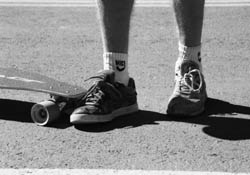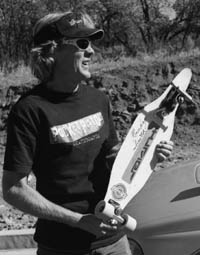
written by Missy
Votel

It’s 10:30 a.m. on a Sunday morning, and Randy Smith and
a buddy are sweeping gravel off a newly paved street in an as-of-yet
undeveloped subdivision in Durango. They hasten about their
business like men on a mission, buffing a particularly steep
section of the road until it’s free of any debris. To
the casual observer, it may seem a strange activity given that
the nearest house is several blocks away. But to those well
versed in the world of slalom skateboard racing, it’s
all part of the ritual.
“People who go into
the backcountry carry shovels,” Smith says. “Skateboarders
carry brooms.”
That’s because, when
topping out at 25 to 30 mph, one small rock can slam a skater
down like a ton of bricks. And Smith’s got the road rash
to prove it.
“Hippers are the worst,”
he said, referring to diggers taken on the hip pointers. “You
can’t sleep.”
Once the street meets their
satisfaction, the brooms are put away and out come the orange
cones. Smith places them, slightly offset, at five-foot intervals
down a 50-yard stretch of road.
It’s a tight course
that most people would have trouble navigating on foot, let
alone on a hurtling piece of wood supported by four Urethane
wheels, but for Smith and fellow racer George Pappas, it’s
just practice.
“The real race courses
are a lot longer,” said Pappas.
 He and Smith, who was a pro racer in the ’70s, are riding
the recent resurgence in the popularity of slalom racing buoyed
by “Dogtown and Z-boys,” a documentary on the ’70s
vertical skating revolution in Santa Monica, Calif., and the
Fat City Racing Tour, a slalom racing series put together by
former California pros John Krisek and Jack Smith. The series,
which has been around for about a year and a half, has drawn
some of the legendary names in skating out of retirement, including
Henry Hester and John Hudson, as well as the attention of Fox
Sports. Although Smith and Pappas, who was an amateur racer
during Smith’s pro days, were based out of Colorado, they
were contemporaries of the infamous Z-boys, often sharing the
bill with them at races, here and in California.
He and Smith, who was a pro racer in the ’70s, are riding
the recent resurgence in the popularity of slalom racing buoyed
by “Dogtown and Z-boys,” a documentary on the ’70s
vertical skating revolution in Santa Monica, Calif., and the
Fat City Racing Tour, a slalom racing series put together by
former California pros John Krisek and Jack Smith. The series,
which has been around for about a year and a half, has drawn
some of the legendary names in skating out of retirement, including
Henry Hester and John Hudson, as well as the attention of Fox
Sports. Although Smith and Pappas, who was an amateur racer
during Smith’s pro days, were based out of Colorado, they
were contemporaries of the infamous Z-boys, often sharing the
bill with them at races, here and in California.
“There was a race series
based out of Summit County called the ARA, for Another Roadside
Attraction, and it was a two-year circuit that went through
five ski towns in Colorado,” said Smith. “All the
good California skaters came out for it.”
Likewise, Smith, who was sponsored
by Turner skateboards, would travel to California. In fact,
he was even at some of the races shown in the Dogtown movie.
But as luck would have it, just as Smith was at the top of his
game – consistently placing within the top four –
the sport took a nosedive.
“In the early ’80s
skating just died and went underground because of all the lawsuits
at all the skate parks,” said Pappas, who traded in his
slalom board for a spot on the Kemper snowboard team.
Twenty years later, Pappas
had all but forgotten about his skateboard, until he ran into
Smith who told him about the race series and goaded him into
getting back on the board. “I’ve been two times
in 20 years,” Pappas said.
Smith himself was persuaded
to dust off the old deck last spring after receiving a call
from former pro and friend, Tommy Inouye, telling him about
the death of Bob Turner, the founder of Turner Skateboards,
who had died of a heart attack last spring. He also mentioned
the upcoming Fat City races in La Costa, Calif., and Hood River,
Ore. “He said, ‘There’s a race this weekend
and all your old bros are gonna be there,’” Smith
recalls.
Smith, who already was on
his way to Hood River, where he spends a few months each summer,
decided to go to the races.
At the races, he said he was
blown away to find that some of the “old bros” were
still ripping like they used to.
“I thought I was fast,
but I wasn’t nearly fast enough,” he said. “I
tend to hit more cones than I used to.”
In fact, Smith didn’t
even qualify at the races, which drew as many as 60 pros.
“All the hot guys now are in their 30s and 40s, even their
20s,” said Smith, who is over 40 by more than a little.
However, Smith did manage
to gain a little notoriety after one of the races when Fox Sports
interviewed him on the death of Turner.
“They interviewed me
as a has-been, giving the historical perspective,” he
said laughing.
Nevertheless, Smith says it’s
not about the glory of winning but just about enjoying the moment
and catching up with old friends after several years.
“There’s eight or 10 guys from the ’70s racing
again, and it’s really been a charge,” he said.
“It’s just a blast, even if I don’t do very
well.”
Yet Smith still shows a glimmer
of the old competitive spirit when talking about an upcoming
race in San Luis Obispo in mid-October.
“I just want to compete
with my bros... who I used to beat.”
|

